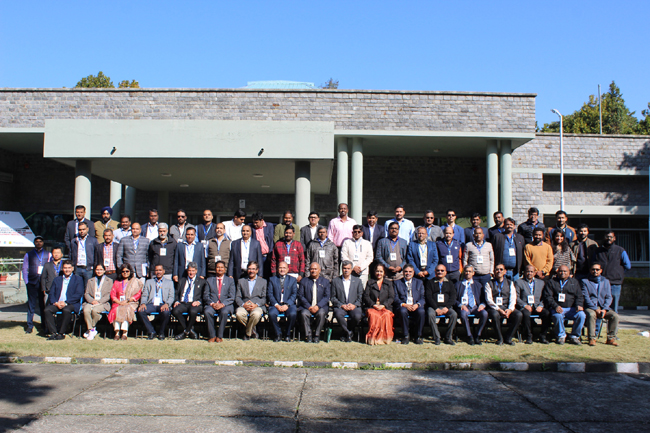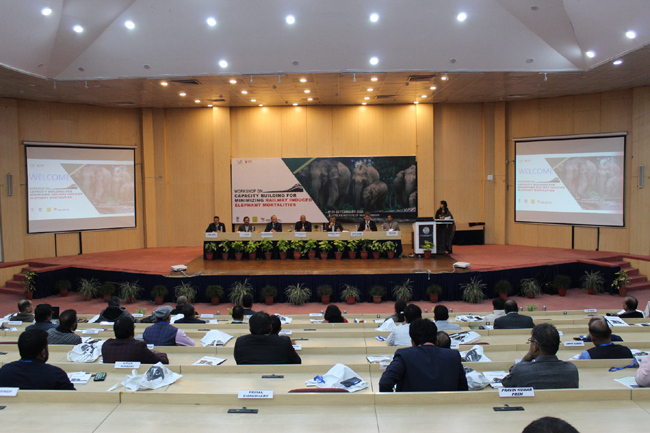

To reduce the impact of railways on our wildlife, it is important to build the capacity of our railway sector by sensitizing railway officials towards India's rich biodiversity and the various mitigation options available to avoid human-wildlife conflict and accidents. In this regard, the Project Elephant Division of MoEF&CC and Elephant Cell, Wildlife Institute of India organized a three-day capacity-building workshop on Minimizing Elephant Mortalities on Railway Tracks for Officials of Indian Railways.
As the Workshop's chief guest, Sh. S.P. Yadav, Director General of the MoEFCC's tiger, elephant, and forest conservation projects, emphasized the importance of striking a balance between conservation and development for our country's sustainable growth. He emphasized how it has been challenging to give straightforward and clear recommendations for mitigating railway-wildlife accidents until now due to the lack of capacity building for the railway sector. Shri Arun Kumar Khandelwal, Principal Executive Director, Gati Shakti, Railway Board, reiterated the Indian Railways' dedication to integrating environmental concerns with its growth initiatives. Sh. Virendra Tiwari, Director, WII, said that the outcome of the program would help guide responsible railway development in consonance with the conservation of elephants and other wildlife in India.
41 officials from various railways departments and training institutes participated in this capacity-building workshop.
India is a megadiverse country, with only 2.4% of the world's land area, but accounts for 7-8% of all recorded species of the world, including about 91,000 species of animals and 45,500 species of plants. India is also the second-most populous country in the world with a population of over 1.3 billion people! To transport and cater to the needs of such a large population, the Indian Railway is the main artery of inland transportation in India.
The Indian Railways is at the core of India's economic development and is among the world's largest rail networks. To cater to India's fast-growing economy, the railway sector has envisaged several expansion and upgradation projects including Vision 2024 to achieve targets of 2024 MT freight loading by 2024. The railway also aims to electrify the entire network by 2023.
Recognized as economic, energy-efficient, and environment-friendly relative to other means of transport such as roads and air, the expansion and upgrading of railways is seen as an important measure in supporting development through large-scale movement of people and goods.
However, railway construction and operation has its ecological effects, and a range of impacts on wildlife and habitats have also been documented. Several of India's passenger and freight trains crisscross through some of the country's most sensitive wildlife habitats, particularly protected areas and corridors in central and eastern India that are home to critically endangered tigers and elephants, amongst other animals. The extensive network of our Railways cuts through several of these forested landscapes, compromising the connectivity of the landscape and resulting in a barrier effect.
India is home to the largest number of Asiatic Elephants, accounting for nearly 60% of the jumbo population. According to a 2017 estimate, India had a total of 29,964 wild elephants. India has 32 elephant reserves covering around 76,508 sq km area across 14 states of the country.
But studies have shown that 30 percent of the country’s wild elephants live in large and contiguous forests, while the rest are distributed across fragmented landscapes that have shrunk amid growing human activities, including cultivation. With the expansion of cultivated land along forest boundaries, elephants are increasingly being drawn to forage for crops such as maize, millets, paddy, sugarcane, and vegetables.
Among the states, Karnataka had the highest wild elephant count in India at 6,049 followed by Assam at 5,719, Kerala at 5,706, and Tamil Nadu - at 2,761.
If we take ten years, 186 elephants were killed on railway tracks between 2009-2010 and from 2011-2021.
Among states, Assam had the highest number of elephant deaths due to train hits with 62 deaths, followed by West Bengal at 57 and Odisha at 27.
Over the past five years, India has lost 494 elephants to train accidents, electrocution, poaching, and poisoning. Train accidents accounted for 80 of these deaths.
While 494 deaths over five years appeared to be a fraction of India’s estimated population of nearly 30,000 wild elephants, such deaths could disrupt herd dynamics and further enhance the risk of human-elephant conflicts. The loss of a single older elephant in a herd is the loss of experience for the others in the herd. The older members in the herds guide the younger ones. In their absence, the younger ones could stray into human-dominated landscapes, increasing human-elephant conflict.
India is a rapidly developing country, and our railway system is an integral part of that growth and expansion. However, with this progress comes the challenge of preserving our precious wildlife, particularly the Indian elephant, which is an emblem of our rich heritage and culture.
The sad reality is that elephant-train collisions have become increasingly frequent in recent years, causing harm to both the elephants' and human lives. It is imperative that we take a collaborative approach to tackle this problem and ensure the long-term survival of these magnificent creatures.
Further Contact :
Dr. Bilal Habib 9410992233
Dr. Parag Nigam 9412974486